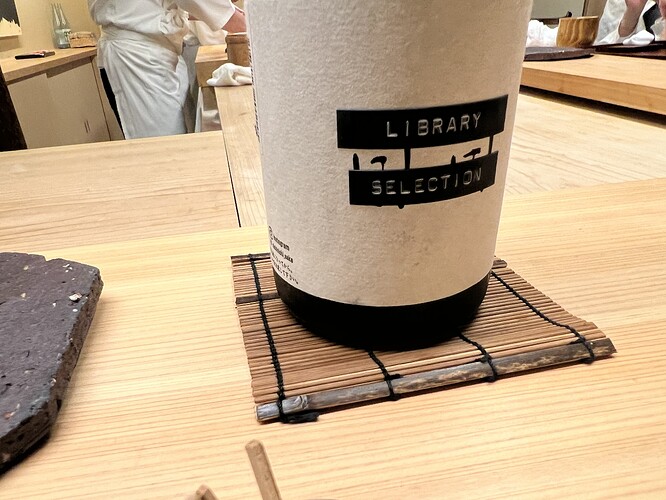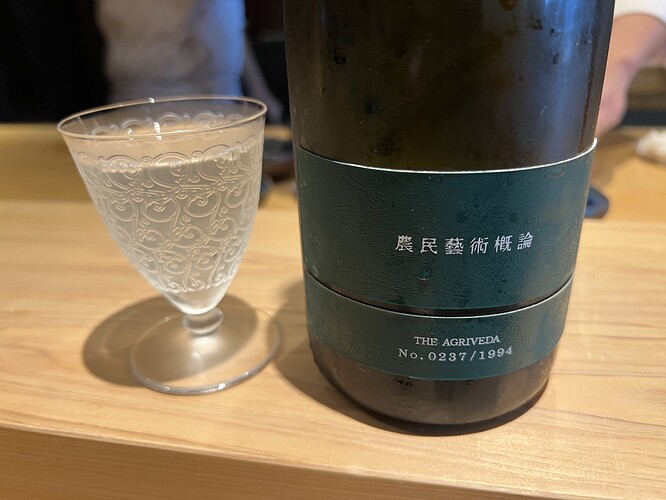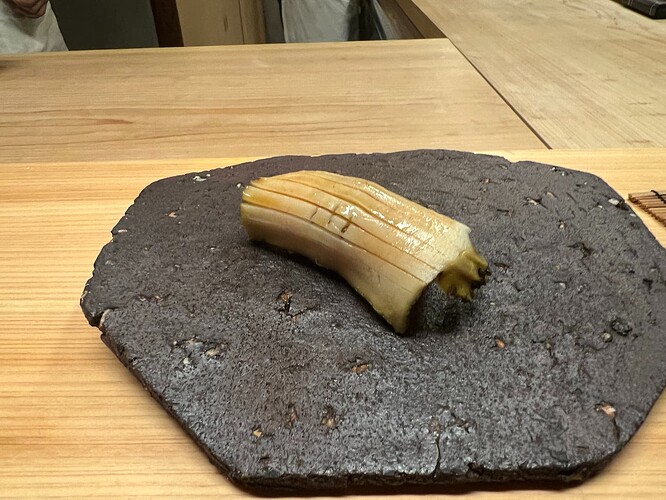Quick 8 days in Japan, mainly Tokyo. Lots of sushi, sake, great food overall with a couple of kappo and 1 French-Japanese as well. Everyone’s tamago was incredible. Loved the seasonal ingredients of suppon, hamo, aji, uni, nodoguro, and awabi. Sticking to max 5 photos for each place for a quick rundown.
Sushi:
Sushi Arai - reliably great sushiya for a place simple in style but with good execution. 6 otsumami, ~16-18 nigiri and small bites including supplements. Just some perfect bites with great shari. Smallish grains, fairly firm, medium warm, salty, packed consistently, great umami that’s so good in reverse olfaction. Not ankimo narazuke this time, so the only perceivable nod to Sushi Sho was the supplemental “ohagi,” which is a must-get. Of course, the maguro is outstanding here, even in summer season.
But the nodoguro (from Tsushima) was a standout this time. Katsuo is also always great, ultra crisp thin skin and silky flesh. Saba, so good had to encore. Excellent calibration with fat vs. chive. “Kuragake” style.
nodoguro
sumiika
saba
anago
kanpyo maki
Sushi Sanshin - one of my favorites, a top 3 sushiya in my experience, and chef Ishibuchi-san is getting even better. His nigiri composure is one of my very favorite, just perfectly proportioned out from the starting shiroamadai. I love the whole experience from start to finish and continue to see why other chefs regard it so highly (several of whom I also visited this trip). Everyone has good things to say about Sanshin, but I love the shellfish in particular and chef Ishibuchi-san’s experimentation. Ayu sujime as nigiri, raw hamo as nigiri with ume, nisshin roll with mekabu and negi, kuroawabi nigiri “roll.” Perhaps the most impressive is the organization / timing and flow, as seen in the kurumaebi and ni-hamaguri prep. And the sheer volume / options.
~6 otsumami with ~23ish nigiri + small bites (like ika geso or grilled hamo skin), including supplements.
ni-hamaguri with yuzu, best
kensaki ika
aji, best
awabi “roll” with liver rice
grape jellyfor dessert next door
Kurosaki - Back at the private counter as I had a business meeting here. With Mukaiyama-san again. I just love it here, for the whole experience, but the shellfish and otsumami are always killer. The hamo with a ginger ankake sauce was lights-out. The unagi from Fukuoka, prepared a hybrid of Kanto and Kansai style, was incredible as well. Shinko, botanebi lightly grilled, akauni nigiri, chutoro, kohada, etc. And the tamago brulee and the kegani chawanmushi, what more can I say? I look forward to returning to the main counter this fall.
~8 otsumami + 14 nigiri.
unagi
ainame no karaage
akamizuke
ni-hamaguri
mirugai
Sushi Namba Hibiya. Second time this summer, but to my surprise I liked the nigiri here more than the otsumami. In June it was the opposite. I tried to pay a little more attention to the details this time, since I had an introduction to his style already. The shari has longer, individual grains, salty with less acidity, good umami, excellent texture. The nigiri is small and at times, a bit tall but draped as the rice can be a touch looser but sticky.
~8 otsumami and ~20 nigiri + small bites, including supplements.
Looking at my notes, I loved the hikarimono - shinko was perfect, kohada excellent with softer vinegar, noticably cooler than the toro that preceded it (and as others do, used like a palette reset after the fatty maguro). Iwashi, saba, and aji, all so dialed in - the aji was perfect, noticeably better than Saito Azabudai’s.
Of course the otsumami is very good, but June’s compositions were a little better for the aoriika (with the adition of junsai for textural play) and ankimo (missing this time), which is second only to Sugita’s for me.
kinki. that broth!
shiroamadai no matsukasa-yaki. incredible texture.
tairagai
kujira
aji, perfect bite
Sushi Shunji - very smooth and overall excellent experience, with really attentive service and good drinks, some nice theatrical presentation like showing the live ingredients, grilling items on the counter, and using lots of beautiful vessels in preparation. I think this meal was even better than last year’s, and though the rice style isn’t my absolute favorite, the neta really shines though and the whole composure is sophisticated and gentle. I think the rice is intentionally a bit fluffier with the Yumepirika varietal (Hokkaido). The shari s moderately warm, with a clean rice flavor, moderately salty, smallish grains a little les firm. A mix of mainly komezu and some light akazu.
~6 otsumami + 16 nigiri and dessert, no extras offered.
A couple of the otsumami weren’t really my speed, but later the sequence of botanebi medium-rare, awabi, bafun uni with awabi kimo sauce, and anago with very fragrant yuzu, then tamagoyaki castella-style was excellent.
anago and cucumber temaki (shari was much redder in here than for nigiri)
hamaguri, very light, layered
uni roll
(upload://sYbYuP85PD1S9J1KbmdB7l6VfN8.jpeg)
bafun uni and awabi kimo sauce. surprised we don’t see this combo more - it’s super delicious. I’m guessing we’ll see this combo in 2025 pop up at a lot of places.
Sushi Kimura - worth the journey to check out this master’s reopened sushiya out in Futako-Tamagawa. Chef Kimura-san is noted for jukusei, aged sushi, and has been expanding a bit recently. But, at the honten in Futako-Tamagawa, which reopened this March, it’s just him and the okami-san (who also subbed in to make some nigiri sequence), both affable and very pleasant.
6 otsumami + 16 nigiri, no extras offered.
There is some experimentation or things done a little bit differently - the boiled tako, awabi, and anago had no wasabi. The awabi didn’t even have nikiri on it, though it was cooked already so it had plenty of flavor.
The rice is firm but mild, good mouthfeel and consistently very nicely packed against some rather plump or at times slightly thick yet slick neta. Chef’s tategaishi movements are fast, powerful, and deliberate, and the formation is consistently excellent. The rice texture is nice, the vinegar is mild, perhaps to allow one to concentrate on the neta’s uniqueness as there as each piece is not your usual preparation.
The otsuammi was good, certainly a bit unique and starting rather clean. Though the last one, boiled kegani crab with egg rice, brandy sauce, sansho, and shichimi was very salty, spiced, and powerful, maybe too much (and with a lot of shell, a little bit difficult to eat elegantly). Probably the best otsumami was the ayu risotto confit or awabi capellini with butter, though I wouldn’t have minded thin slices instead of many small cubes of abalone.
awabi capellini
shiroebi, aged 1 week. great textures - you feel the harder rice.
kodai, aged 5 days, very plump
kujira, aged 10 days. slick. i had a slight preference for Namba Hibiya’s.
akami with umeboshi. creamy and bright.
Sushi Saito Azabudai - new satellite shop of Sushi Saito in Azabudai Hills, run by chef Takimoto from the Saito affiliate Sushi Tsubomi. Great deal for nigiri lunch, about $110 for 11 piece + a small mozuku, piece of maki and tamago custard. Not at the same level as higher-end sushiya, naturally, but overall enjoyable for the price. They even take walk-ins occasionally. It’s next to the Yamayuki boutique in the Azabudai Hills market.
The best piece was aoriika or ishigakikai. The tamago pudding is excellent, lightly sweet on top, with great umami, but a touch firm at the bottom end.
The shari is well defined, slightly firm and warm, enjoyable. Light akazu, though you couldn’t really tell by the looks of it. Generally, well-composed and light but pretty sophisticated in taste, though the katsuo and aji were let down by the negi. I don’t really like how they prepare the maki and let it sit for 20 mins or so - Sushi Shunji did this as well with the uni maki both times. I believe the idea is to let the uni (or in this case, torotaku) permeate the roll. But here, the effect wasn’t good - the seaweed was a bit wet, and the torotaku combination wasn’t that well integrated.
Expectations here might run a bit high for tourists given the Saito name (unlike the other affiliates Sushi Tsubomi or 3110NZ by LDH Kitchen), but I think that lunch is the play here for value. For $110, it’s hard to ask for much more. One can of course have better sushi, but probably at a higher price point.
menchidai - good to allow the rice to sine
ishigakikai - very nice
aji - otherwise good piece marred slightly by the topping. too sharp or something.
uni - very good
torotaku roll, kinda soggy
Kappo:
Ginza Shinohara - this is a very famous and celebrated kaiseki restaurant, with strong storytelling and sense of Japanese traditions. To me, it’s more about the whole package than the food itself, which of course was good, but perhaps not the main reason why it has its status.
The signature hassun course is elaborate with many tastes, and this time was a celebration of Obon festival (hence the symbolic horses and cows, cucumbers and eggplant, presented at first with small lanterns as they turned off the lights).
The opening somen in a hand-carved ice bowl was very refreshing. Somen with uni, shiitake, shiso, aburaage, spinach, goma, and dashi - perfect way to cool down.
The monaka is also a famous serving - here, it was foie gras with mango, passionfruit, and lemon
Ayu is served 2 ways for comparison - cooked on a stick by bincho and also as nigiri (hot with guts removed, split and put on kuragake style, no nikiri sauce).
Supplements: botanebi with aoriika, brandy, and uni sauce (you may recognize from elsewhere also…), ok maybe a bit strong; Hida beef (very good); fried fugu with lemon and salt (pretty good).
Best dish was probably the grilled Lake Biwa ayu and then the grilled fig with white miso, which had great aromas.
Drink list is a bit classic luxury, not quite as interesting as I was hoping for. To me, the food is similar at Ginza Kitagawa (chef Kitagawa was one of the chefs at Ginza Shinohara) .
somen
ayu
hassun
suppon with ginko
scallop furai, manganji peppers, corn gohan
Kappo Muroi - from a promising young talent Go Muroi in Nishi-Azabu, with experience from the celebrated kappo Yamazaki nearby and Kichisen in Kyoto. All 10 courses plus dessert were strong, in fact almost all were excellent.
Katsuobushi is shaved a la minute to start the meal. The first dish of kamonasu with junsai, murasaki uni, and ginger dashi was quite nice, but it sat a little because some other guests were late. The next 5 dishes were really great. Niebana, rice as a flower: al dente rice, cooked with seaweed dashi, karasumi that felt a little medium, ginko, yuzu - nailed it. Great mouthfeel, with the nice spoon as well - slippery, glossy, even the ginko was cooked very nicely to this effect.
Shiokoji-marinated nodoguro grilled over burning hay. A bit sweet salty, fat, and rare. Incredible. Nice ponzu oroshi or just wasabi and salt. With some myoga nutaae underneath for balance (and maybe some kabosu juice)? Super good.
After crab somen with fruits tomato, suppon karaage, and two rice courses, even the dessert was well-calibrated. A milk gelato with gentle coconut fragrance and salt, Miyazaki mango, and a bit of lemon.
Tight edit on the drinks list - just my style. Only champagne, white burgundy (+ one bottle of Kongsgaard), red burgundy, and sake. Just Ubusuna, Nichi Nichi, Aramasa, and Jikon, a big lineup of each priced very nicely. On that note, you can feel free to try various offerings for comparison.
I plan on returning for sure. I’m really liking these talented chefs who are relatively young but have good experience both in traditional places and celebrated, younger places. Hakuun, nearby, is another great one.
niebana (rice) with karasumi, ginko, and yuzu
nodoguro, crisped skin but rare. incredible.
renkon mochi age with suppon ankake and karashi. Beautiful aroma like taro and a damn pure suppon dashi ankake sauce. Excellent textures - the lotus root was slivered thinly, so it had a fresh crunch but well-proportioned bite compared to the deep ankake sauce, ultra savory like pure chicken and seafood broth. With light karashi mustard, so nice in reverse olfaction.
kai shabu shabu - here, awabi and hokkigai in a hamaguri dashi. Great textures of course, beautifully balanced with the asparagus. The idea of shibumi came to mind.
unagi and corn gohan
New French:
Ginza Oishi - a diverse dinner party of sorts between kappo and French, with luxurious ingredients but in a casual and fun environment. What’s impressive is the breadth of chef Oishi-san’s repertoire - one minute he’s cooking a tachiuo pie, the next a hassun plate with ayu pan-fried wrapped in potato, then squab in the style of Peking duck (cooked here by ladling hot oil over it), kurumaebi tempura tacos with manganji peppers, then deer with a “sauce gibier,” butter abalone
rice pot, curry rice, etc. Chef is very extroverted and it’s a fun time. A bit smoky from the grill and it’s not nearly the polished meal of say Sugalabo, but it’s a different kind of experience that’s a rather good value considering the ingredients you get (which I think accounts for some of their Tabelog success).
ingredients display
uni with cauliflower creme, beef consomme gelee, shiso
tachiuo and cucumber pie
ayu with crispy potato
deer with cauliflower creme, sauce “gibier” with foie gras, fried Filipino bananas
Other:
Sanchokuya Taka - an “izakaya” in a sense but with basically all you can drink with 10 dishes or so of the day’s seafood direct from fisherman. They aren’t courses so much so it’s not really your typical meal, but really a casual “fisherman’s food” kind of experience - seki saba, ensui uni, kue, hamaguri grilled on shell, etc. just simple but good to very good quality seafood. Besides a welcoming beer, you’re here to drink sake only - tons of Jikon (counter is lined with like 20+ bottles), Nabeshima, Hooubiden, Sharaku, etc. The rare unagi just seared was super good, as was the whole mehikari that was super fatty (you eat it, bones and all). Then there’s the signature “the bomb” - mixed whole awabi with its liver, ikura, kazunoko, mekabu, wasabi. A whole awabi (and sourcing changes monthly. Great aroma.
No pictures, among many other rules, but a very good experience if you want to drink sake and eat simple but good seafood amongst locals.
Nakameguro Nodoguro Bouan - a members place with a nodoguro course menu for a pretty fair price. I was taken here by a friend so I didn’t take notes, but we ate about 5 nodoguro between the two of us. Both the very fatty donchichi brand and another one. The chef was nice and there were some good bites indeed among all the preparations - from grilled whole, to sashimi, rice pot, bozushi, etc. The sake unfortunately was a letdown.
sashimi and bozushi
being cooked slowly
shabu shabu
whole
gohan with cha-mame
Tendon Kaneko Hannosuke Nihombashi Honten - queue didn’t look too bad in the morning; waited about 45 mins. Delicious and a good value. Not sure I’d get the crab version again; the standard one is the sweet spot of value for me, but I can’t complain with the exchange rate. This was super satisfying.
Ueno Seiyouken Ginza Matsuya. For some reason, the others I wanted to go to (Ponta Honke, Grill Grand, Kurofunetei) were all closed that day, so I ended up here. Crab croquette, hamburg rice with madeira sauce, and ebi furai. Not bad. Nice fry, but overall, I can imagine better versions of the hamburg rice, and I think that Ponta Honke’s sauce in particular is better.
Cocktails:
Memento Mori - a place by the Mixology group specializing in cacao cocktails. They had some interesting spirits, besides their own cacao gin, such as foie washed vodka. The menu here is broad, sorted by cacao origin. They also had some nice looking shrimp tacos! Good spot to drop by before/after eating at Toranomon Hills’ Yokocho.
Folklore - also by the Mixology group, a place specializing in shochu or sake cocktails. Really neat to explore these a bit. The “Petal Paloma” with Daiyame shochu, which had an elderflower / lychee nose, was an elegant take on a paloma, with nicely balanced grapefruit and lime. And their green apple one, with aged sweet potato shochu and rose syrup, was really nice with some fresh dill and a castelveltrano olive. Don’t miss the wagyu jerky, which goes nicely with their “smoky bonito” cocktail of sesame shochu, pineapple, Laphraoig, and miso powder, which does taste of its namesake.



















































































































